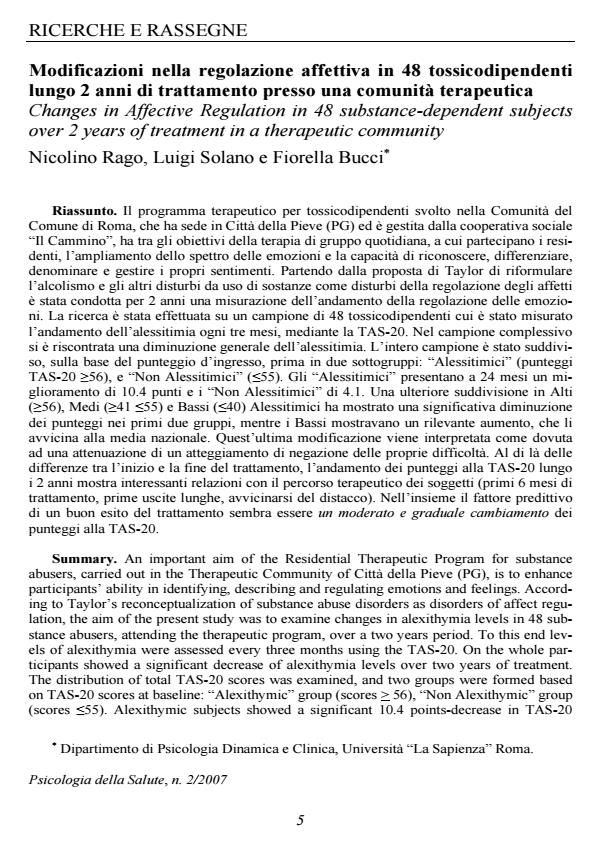Modificazioni nella regolazione affettiva in 48 tossicodipendenti lungo 2 anni di trattamento presso una comunità terapeutica
Journal title PSICOLOGIA DELLA SALUTE
Author/s Nicolino Rago, Luigi Solano e Fiorella Bucci
Publishing Year 2008 Issue 2007/2
Language Italian Pages 20 P. 5-24 File size 334 KB
DOI
DOI is like a bar code for intellectual property: to have more infomation
click here
Below, you can see the article first page
If you want to buy this article in PDF format, you can do it, following the instructions to buy download credits

FrancoAngeli is member of Publishers International Linking Association, Inc (PILA), a not-for-profit association which run the CrossRef service enabling links to and from online scholarly content.
An important aim of the Residential Therapeutic Program for substance abusers, carried out in the Therapeutic Community of Città della Pieve (PG), is to enhance participants’ ability in identifying, describing and regulating emotions and feelings. According to Taylor’s reconceptualization of substance abuse disorders as disorders of affect regulation, the aim of the present study was to examine changes in alexithymia levels in 48 substance abusers, attending the therapeutic program, over a two years period. To this end levels of alexithymia were assessed every three months using the TAS-20. On the whole participants showed a significant decrease of alexithymia levels over two years of treatment. The distribution of total TAS-20 scores was examined, and two groups were formed based on TAS-20 scores at baseline: Alexithymic group (scores > 56), Non Alexithymic group (scores =55). Alexithymic subjects showed a significant 10.4 points-decrease in TAS-20 scores during 24 months of treatment; Non Alexithymic subjects showed a 4.1 pointsdecrease. A further categorization into High (=56), Intermediate (=41 =55), Low (=40) alexithymics showed a significant decrease in scores over treatment in the first two groups, while the Low showed a significant increase, reaching proximity with the national average. This last pattern is interpreted as due to softening of an attitude of denial of difficulties. It is worth noticing that changes in alexithymia levels, examined during two years of treatment, are significantly associated with the different phases of the therapeutic program (first 6 months of treatment, first contacts with the external environment, end of the treatment). On the whole a moderate and progressive change in alexithymia levels seems to be a predictive factor of positive treatment outcome.
Nicolino Rago, Luigi Solano e Fiorella Bucci, Modificazioni nella regolazione affettiva in 48 tossicodipendenti lungo 2 anni di trattamento presso una comunità terapeutica in "PSICOLOGIA DELLA SALUTE" 2/2007, pp 5-24, DOI: